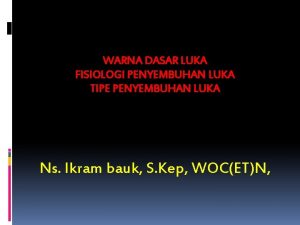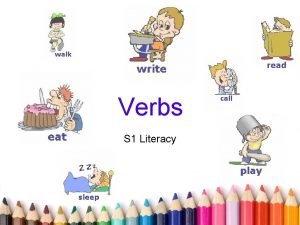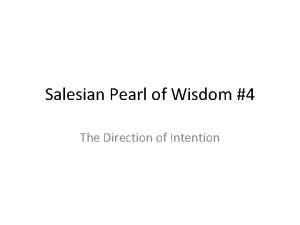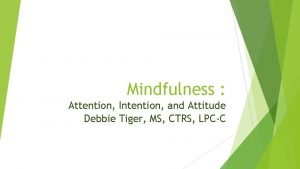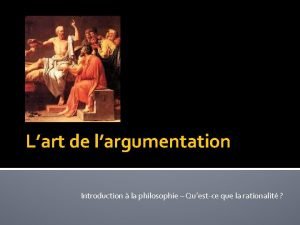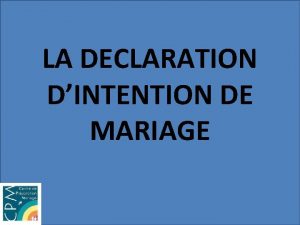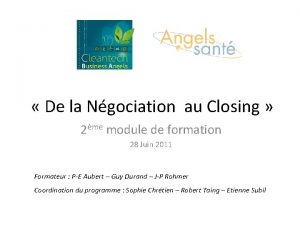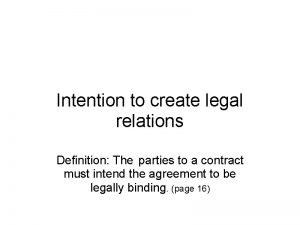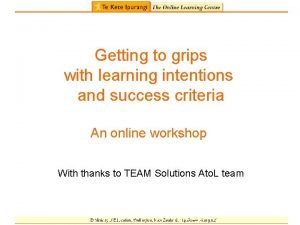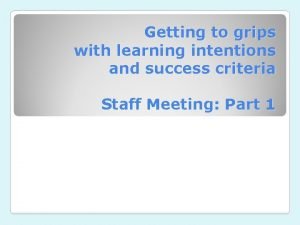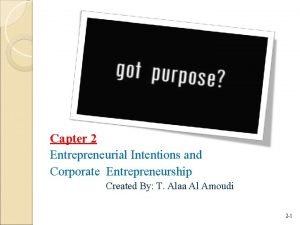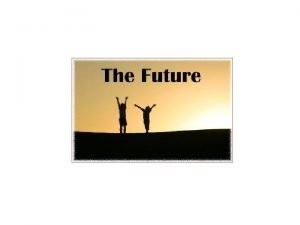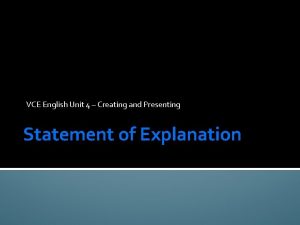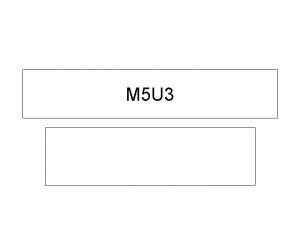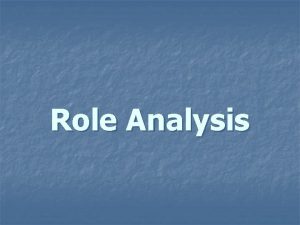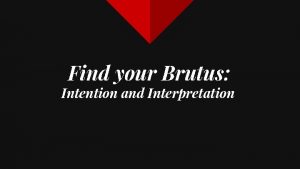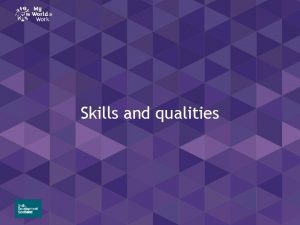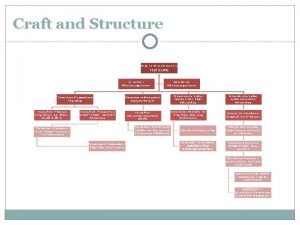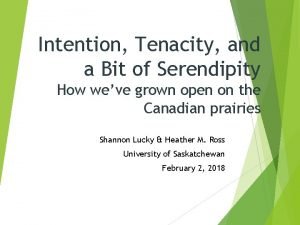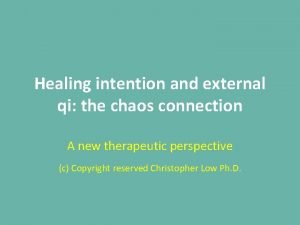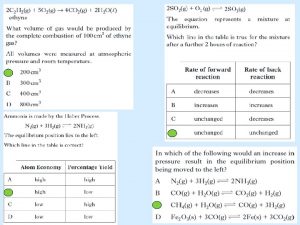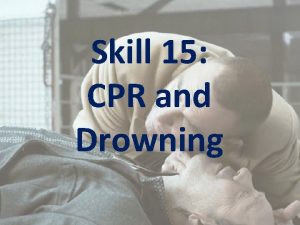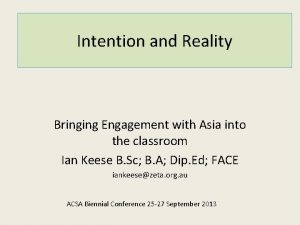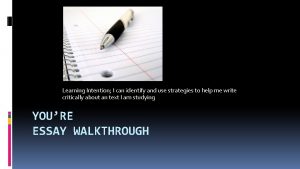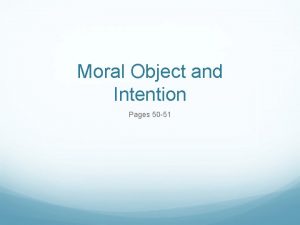WHAT IS THE ROLE OF THE INTENTION AND



















- Slides: 19

WHAT IS THE ROLE OF THE INTENTION AND THE GOAL ON THE SUCCESS OF ACUPUNCTURE THERAPY? Dr. Barbora Danhova Rehabilitation Centre, Pribram‘s Hospital The Czech Republic bmichl@seznam. cz

What else matters in addition to acupuncture therapy to be successful? How to improve the effect of acupuncture? a cure is affected by the nature of the disease: - the condition and the response of the organism - age - ability of the body to react - skills of the doctor - the mental state has a great influence in the attitude towards the disease In my practice I respect the indications and contraindications of acupuncture. The acupuncture works best for malfunctions, illness or reversible in the latent stage. It has an excellent effect if there has not been fixed pathological processes yet.

How many percent of clients want to really recover? How many clients is decided to recover? n n It is known that for about 5 -15% of the people acupuncture does not work, mechanisms of acupuncture are not working. At work, who studied tens of studies in Europe and America /Understanding the Intervention and Implementation Factors Associated with Benefits and Harms of Pay for Performance Programs in Healthcare/ it is clear that to allow improvement in the efficiency n and quality of the health care, certain extra paid programs can be used for the health care. This means that the client is more determined to heal, to cure that does something extra, a cure for him is more important. I know from my experience that if a client in a hospital uses so-called free care as we have in the Czech Republic than the effect is small, but if you visit a private practice where he paid extra for the care, the clients are more determined to heal, and the results are better. It is a type of motivation. According to the results of the work / Gerace, Germany 2002 -2008 / the acupuncture has a double effect on the back pain than conventional medicine including the rehabilitation. (3)

The Casuistic of the client with the significant radicular syndrome irritation extinction. She resolved without surgery, even with a significant change in MRI images

Introduction The back pain is a common cause of the working incapacity in our country, it often ends by operation if the conservative treatment does not work. In case of the report the statement was for the solution of operation and the recommendation of the surgeon was to operate Thanks to the decision of the client along with the acupuncture care and the rehabilitation, the client recovered without the neurological findings.

The Casuistic 47 - years old client from 10/2013 treated in the neurology department of Pribram’s Hospital with the heavy and immobilizing back pain syndrome with radicular syndrome S 1 irritative extinction on the right side. The client went in the antalgic position, she had a cruel pain, in an objective statement there was a shifting to the right of the pelvis, she could not bend over, she had completely blocked the movement of the lumbar spine, she had the Lasegue on the right 10 -20 st. , the reflexes L 2/4 were mutually equipped, but the reflexes L 5/ S 2 was disappeared on the right side. She had reduced muscle strength of the right leg, especially on the flection in the ankle. On the neurology department she had infusion therapy: the lytic infusion (Guaifenesinum 50 mg (5%), Trimecaini hydrochloridum 10 mg, Natrii salicylas 100 mg (10%)) the rehabilitation - positioning and activating of the deep stabilization system.

The MRI image n 11/2013 of the lumbar spine at the area L 4/5 there is asymmetric protrusion medially to paramediat to the right, the size 3 mm. The region L 5/S 1 there is disc herniation in the foraminal to preforaminal the right size. 8 x 12 x 9 mm, fill the right lateral recesus which pushes the outgoing root S 1 on the right. Focal herniation (extrusion) of the disc L 5/S 1 preforaminal with the pressure to the leaving root S 1 on the right.


From 12/2013 she had the Acupuncture therapy Initially she had the fullness of yang, cold of the urinary bladder, she had sensitive the following points: GB 34: the systematic point for the muscles and the tendons, decrease the cramps, the hypertension of the muscles, tendons and ligaments. The Ligaments provides strength, stability and affects the coordination of the movement. The Local points The Hua Tuo points -L 4/5 and L 5/S 1 the intense muscle-relaxant effects to the paravertebral pain BL 25 - shu of the large intestine, it strengthens the lumbar region and legs, it is again stiffness and rigidity of the back spine BL 54 – it strengthens the lumbar region, it activates the track and moderate the pain. BL 40 - the tendon releases and eliminates obstruction of the tracks, weakness and numbness from wind and wet, cold sensation in the lumbar region BL 60 – it suppresses the wind, activates the whole path of the urinary bladder, it relieves the pain, relaxes the tendons, strengthens the lumbar spine BL 62 - analgesic and muscle-relaxant effect, calm the spirit, activates the track and moderate the pain. BL 30 31 - the back spine stiffness, the pain from cold, the tingling and weakness of the limbs BL 35 – sghten the coccyx area, the lumbar pain

The kidney qi distress syndrome Shenqi Xu Zheng The weakening of the kidneys deplete during the movement, the emptiness of the kidney and the lung, the lack of the energy, stress, the mental and physical fatigue, the nervousness. the symptoms: prolonged breath, impaired breathing, sweating, strong cold, cold of the limbs, weakness in the shoulders and knees the pulse: submerged, thin the tongue: blanched The point of the global effect I used: KI 3 – it strengthens the kidney, strengthens the hip and the knee, anchors qi and has positive effects on the lungs KI 6 - it abundant yin of the liver and the kidney, it calms the spirit, KI 7 - it supplements the kidney, increase yin, expands the water and strengthens surfaces, strengthens the lumbar region BL 23 - refill the kidney, nourish the kidney essence, nourishing the blood, the yin kidney, disperse wet, strengthens the lumbar region. GV 4 - calms the tendons, harmonizes the blood, improves the function of the lumbar spine, eliminates the cold LU 7: strengthens the lungs, calm the pain ST 36 it strengthens and complements qi, it distracts the cold, the wind and the wet disperses For the calming down the client and the anxiety PC 6 she was coming to the Acupuncture therapy- initially 2 x a week, later once week

The objective findings 1/2014 back spine pain was reduced, she felt better, but still she had irritation extinction syndrome S 1 on the right, but Lasegue was better on the right, reflex L 5/S 2 was improved on the right. From 2/2014 she continued with the rehabilitation. 3/2014 she had less pain, she had better muscle strength in the ankle on the right side 4/2014 she had complex spa treatment and then she continued with rehabilitation, the positioning and activating of the deep stabilization system. 5/2014 she had moderate the pain and the client adheres the program for vertebropaths, she was limiting the rotational movements of the lumbal spine, the pain was only during the disproportionate movements. 2 -3/10 improved the muscular strength of the right leg, the reflex L 5/S 2 was symmetrical

The MRI images from 1/2015 the lumbar spine in the area L 4/5 there is disc protrusion broad-based medial to right paramedial, the width is about 4 mm and it is in the small cracks in the annulus fibrosus, on the both sides. The deck L 5/S 1 is a broadbased disc protrusion paramedian on the right only 2 mm width, minimally overlapping and mutually to the foraminal space. Significant improvement.


The Conclusion The client care was usual and standard, but it is a demonstration of that the finding on MR imagines can be significantly improved. In addition, the treatment included acupuncture therapy. The main and the decisive factor in the healing of the client was her mental condition, the excellent motivation and the cooperation, as well as care and trust in medical assistance. A significant factor has been from the beginning the decision of the client to be fully cured, not to be just treated and she kept this persuasion along the way. She was decided she will not need a surgery and she will recover. She described this decision to me during the treatment, but in the end, when she was already well, I asked her what was the most encouraging for this decision? It was a trust in physicians, other health care professionals and the at most support of her own decision to recover and that she will not need the operation. Why clients remain chronically ill? They remain chronically ill because they have not enough motivation to recover.

Finally it is important which goal has the client not only for the treatment but also for the life It is often forgotten that we are not responsible for the health of the clients, or the health system but the clients themselves. We can recommend, suggest what is good to do. Each of us is responsible for his own life and it's up to him how he lives and how he perceive the world. It depends enormously on the decision for what we decide and how we want to live: I will be just in the process of healing or I see myself fully healed? Want I only help myself? It brings me a particular advantage to be ill? Social benefits? Am I escaping from something? It depends on how much longer I'll be worried about something, how long I'll be sick, how long I will have discomfort because they can be solved and can be recovered.

Let's think about what you want, not what you do not want The goal is what I want, I desire, what I expect. If I reach a certain goal, it depends on the strength of my inner decision. The goal is to hit the target, it is my will, the setting, it is the force that lifts us out of the chair and forces us to do something. The goal is what leads me to the finish, there are the concrete steps that determine how quickly and effectively I reach my target and it is very basic what I personally do for my goal. We have it within us inside, even without words, it is the inner feeling - I know that this would happen and sometimes we remember only later that we wanted it to have it though we went there. The goal can be positive /to recover/ as well as negative – /I will not recover, I don’t improve, nobody helps me, they made me/. The goal must have the clients /to recover/ but also the health professionals - doctors / I will cure them, get them out of / We have the programs and ideas that lead to the goal and for realizing is important how many of the programs or thoughts lead to the goal or divert from the goal. Clients often say what they don’t want and then they wonder why the things they do not want are happening to them.

Sometimes people have a lot of goals and they are different: I want to change job, have a lot of money, but also be healthy or they have the goal with conditions, they give there their ideas and there is not freedom for the implementation way, they push, they fear and push something what can not be changed. It is good to give the goal freedom - let it be to find a way, for therapist the appropriate treatment. I know that I recover, I am ideally healthy is the best plan for recovery. If you have discomfort or unpleasant thoughts appear you can remove them by different psychotherapeutic approaches: - the Acupuncture, homeopathy, the methode RUS /www. metodarus. cz/ Everyone is capable to achieve anything. Whatever achieved another man, may achieved another person on this planet. It is as if you are in a skyscraper, you get into the elevator, it's just my decision, you can go anywhere, any floor of the skyscraper. If the intention is too low / I do not want to be sick- it is not to be recovered/ higher plan is - /I want to feel better, I want to be happy, I am healthy and I am ideally happy or I ideally live a happy life/.

I wish your all clients are recovered and live a happy and satisfied life

The Literature n n n n n Understanding the Intervention and Implementation Factors Associated with Benefits and Harms of Pay for Performance Programs in Healthcare, Evidencebased Synthesis Program, Investigators: Karli Kondo, Ph. D, Cheryl Damberg, Ph. D, MPH, Aaron Mendelson, BA, Makalapua Motu'apuaka, BS, Michele Freeman, MPH, Maya O'Neil, Ph. D, Rose Relevo, MLIS, MS, and Devan Kansagara, MD, MCR. , Washington (DC): Department of Veterans Affairs (US); 2015 May. A systematic review of the clinical effectiveness and cost-effectiveness of sensory, psychological and behavioural interventions for managing agitation in older adults with dementia, Health Technology Assessment, No. 18. 39, Gill Livingston, Lynsey Kelly, Elanor Lewis-Holmes, Gianluca Baio, Stephen Morris, Nishma Patel, Rumana Z Omar, Cornelius Katona, and Claudia Cooper. , Author Information, Southampton (UK): NIHR Journals Library; 2014 Jun. Fiala, P. : Akupunktura ve 21. století, Mladá Fronta a. s. , 2016 acupunctura Bohemo Slovaca 4/2016 Bangha, O. : Akupunktura a VAS: Mýty a realita, Acupunctura Bohemo. Slovaca 3 -4/2008, s. 78 Barešová, M. : Akupunkturní postupy při léčb patologií hybného systému, Acupunctura Bohemo. Slovaca 3 -4/2004, s 11 -18 Ondrejkovičová, A. : Akupunktura vo fyzioterapi, balneologii a liečebnej rehabilitacií, Acupunctura Bohemo. Slovaca 1 -2/2007, s 6 -7 Šmirala, J. a kol. : Základy praktikej akupunktury, Inštitut pre dalšie vzdelavanie lekárov a farmaceutov v Bratislave, 1991 literatura od dr. z Hradce a klasika akup – syndromy. !!!!! doplnit
 What is web role and worker role in azure
What is web role and worker role in azure Krappmann modell
Krappmann modell Statuses and their related roles determine the structure
Statuses and their related roles determine the structure Tipe penyembuhan luka
Tipe penyembuhan luka Verbs for learning intentions
Verbs for learning intentions Direction of intention
Direction of intention Direction of intention prayer
Direction of intention prayer Mindfulness intention attention attitude
Mindfulness intention attention attitude Pente fatale exemple
Pente fatale exemple Lettre d'intention mariage
Lettre d'intention mariage Table de capitalisation
Table de capitalisation Creative intention meaning drama
Creative intention meaning drama Intention to create legal relations meaning
Intention to create legal relations meaning How to write learning intentions
How to write learning intentions Examples of learning intentions
Examples of learning intentions The intention to act entrepreneurially
The intention to act entrepreneurially Arrangement intention prediction
Arrangement intention prediction How to write a statement of intention vce english
How to write a statement of intention vce english Direction of intention
Direction of intention Direction of intention
Direction of intention



